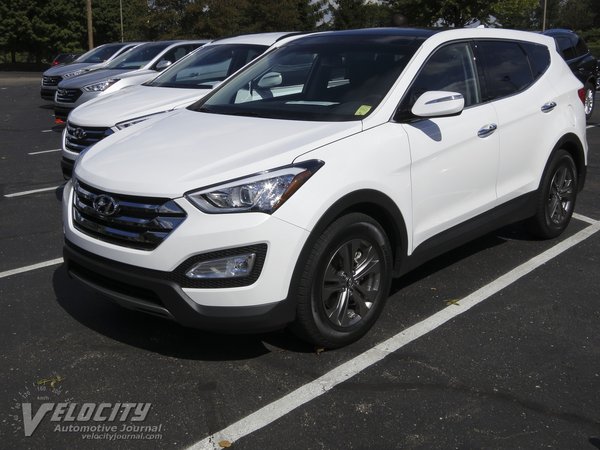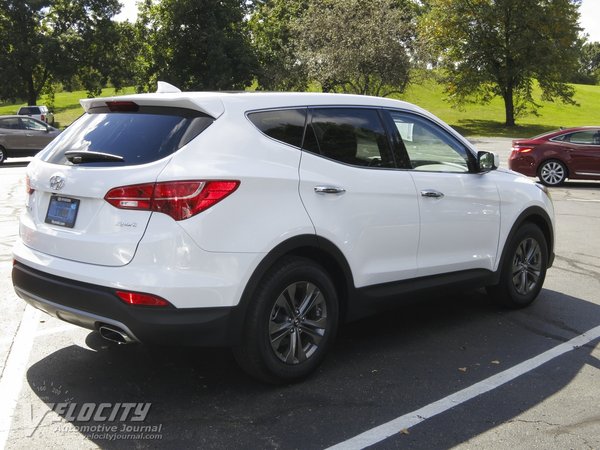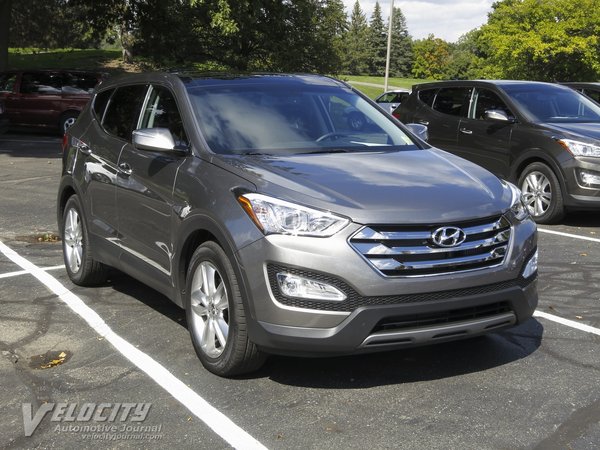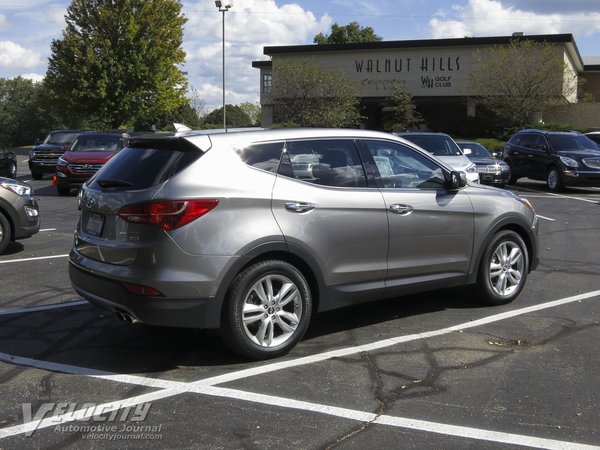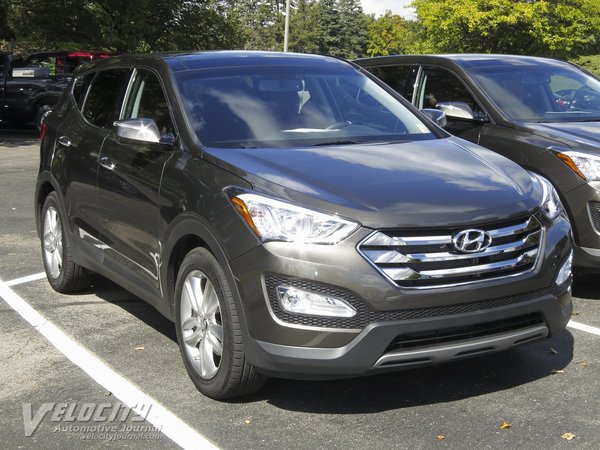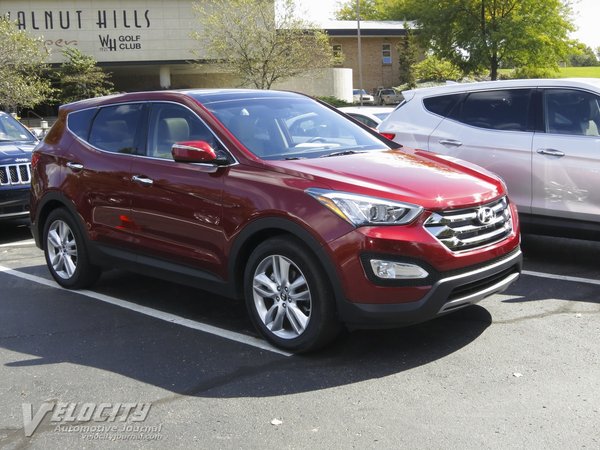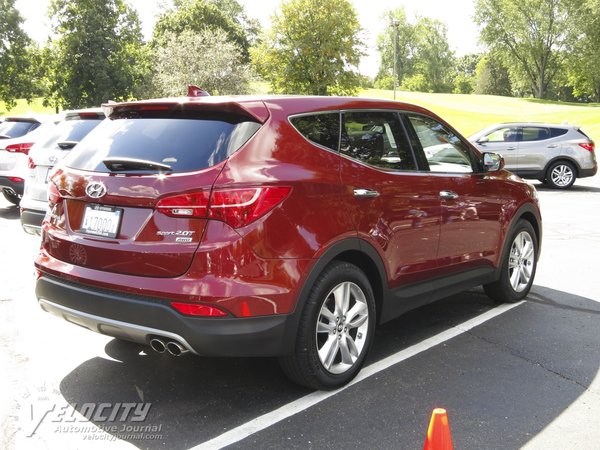2013 Hyundai Santa Fe Sport
09/24/2012
Shahed Hussain
Hyundai adopted a two model strategy for the 2013 Santa Fe. The new 5-passenger Santa Fe will be complemented by a longer Santa Fe with seating for seven. Engine choices consist of a 2.4L inline-4 or a 2.0L turbo four, both coupled to a 6-speed automatic. Both powerplants are available in front-wheel drive (FWD) and all-wheel drive (AWD) configurations. The Santa Fe shares engines and its platform with the midsize Sonata sedan.
The lineup starts at $24,450 for the front-wheel drive 2.4L Santa Fe Sport. Add all-wheel drive and the sticker price rises to $26,200. The FWD Sport 2.0T bumps up the MSRP to $27,700, or $29,450 with AWD. Options packages for the 2.4L Sport include the Popular Equipment Package ($950), Leather and Premium Equipment Package ($2,950), and Technology Package ($2,700). Only the latter two packages are available for the Santa Fe Sport 2.0T, costing $2,450 and $2,900 respectively. Notable items in the Leather and Premium Equipment Package include pushbutton start, leather seating surfaces, power passenger seat, heated rear seats, and rearview camera. The Technology Package adds a navigation system, premium audio, panoramic sunroof and heated steering wheel. Equipped with the Leather and Premium Equipment plus the Technology Package, the total sticker price for the FWD 2.0T added up to $34,175, or $35,925 for the AWD 2.0T.
Inside the Santa Fe Sport is ample evidence of Hyundai's superb material and build-quality standards. Most surfaces are soft touch and panel gaps are tight and uniform. Chrome and silver accents contrast with the mostly dark gray interior hues. Simulated wood trim is limited to a narrow swath across the dashboard and around the outboard vents. The leather-wrapped steering wheel has integrated controls for audio, Bluetooth, and cruise. An 8-inch touchscreen is the interface for the audio, climate control, and navigation system. An auxiliary input and USB port on the center console allows media player audio/video connections. Dual 12V power outlets can charge multiple accessories. The optional perforated leather seats provide reasonable support without being confining. Both driver and front passenger seats have power adjustments. Dual cupholders are conveniently located on the center console. The rear seats accommodate three occupants, but the center armrest compromises comfort for the middle passenger. Under the cargo floor is a hidden compartment for storing valuables.
Hyundai eliminated the V-6 from the Santa Fe Sport, replacing it with a turbocharged 2.0L inline-4. The 2.0T is rated at 264-bhp @ 6,000 RPM and 269 lb.-ft. from 1,750-3,000 RPM. With its ample midrange torque, the all-aluminum turbo four matches the throttle response of a comparable V-6. The normally-aspirated 2.4L cranks out 190-bhp @ 6,300 RPM and 181 lb.-ft. @ 4,250 RPM. Both powerplants are mated to 6-speed automatics with nearly identical gearing, but the 2.4L gets a shorter final drive ratio. EPA estimated fuel consumption for the Santa Fe Sport FWD 2.0T is 21/31 MPG (city/hwy.) and 22/33 MPG (city/hwy.) with the 2.4L inline-4.
The Santa Fe Sport uses the typical MacPherson struts, coil springs, and stabilizer bar in front; at the rear is a multilink setup with dampers, coil springs and stabilizer bar. Disc brakes are at all four corners with ABS and stability control standard. The standard 17-inch alloy wheels with P235/65R17 Continental tires are upgraded to 19-inch alloys and P235/55R19 tires for 2.0T models. As is becoming increasingly common, the Santa Fe Sport adopts electrically-assisted power steering with 2.95 turns lock-to-lock.
Suspension tuning for crossovers can be especially difficult, but Hyundai engineers have met the challenge. Firm damping keeps the chassis under control, but preserving enough suspension compliance to absorb bumps and potholes. Aiding the Santa Fe Sport's handling is its low curb weight, ranging from 3,459 lbs. (2.4L FWD) to 3,706 lbs. (2.0T AWD). The AWD system available in the 2.0T eliminates any traces of torque steer, while providing confident handling on dry roads. Not surprisingly, the FWD 2.0T showed moderate torque steer under acceleration, and lacked the overall stability and composure of the AWD Santa Fe Sport on the highway.
Hyundai has aimed the Santa Fe Sport directly at the heart of the crossover segment dominated by the CR-V, RAV4, Escape, and Equinox. As expected, Hyundai packs an impressive array of standard and optional equipment at a price point unmatched by its competitors. Considering the Santa Fe Sport's superb build quality, along with its above average ride and handling, turns this Hyundai into a top choice for value-minded customers.

